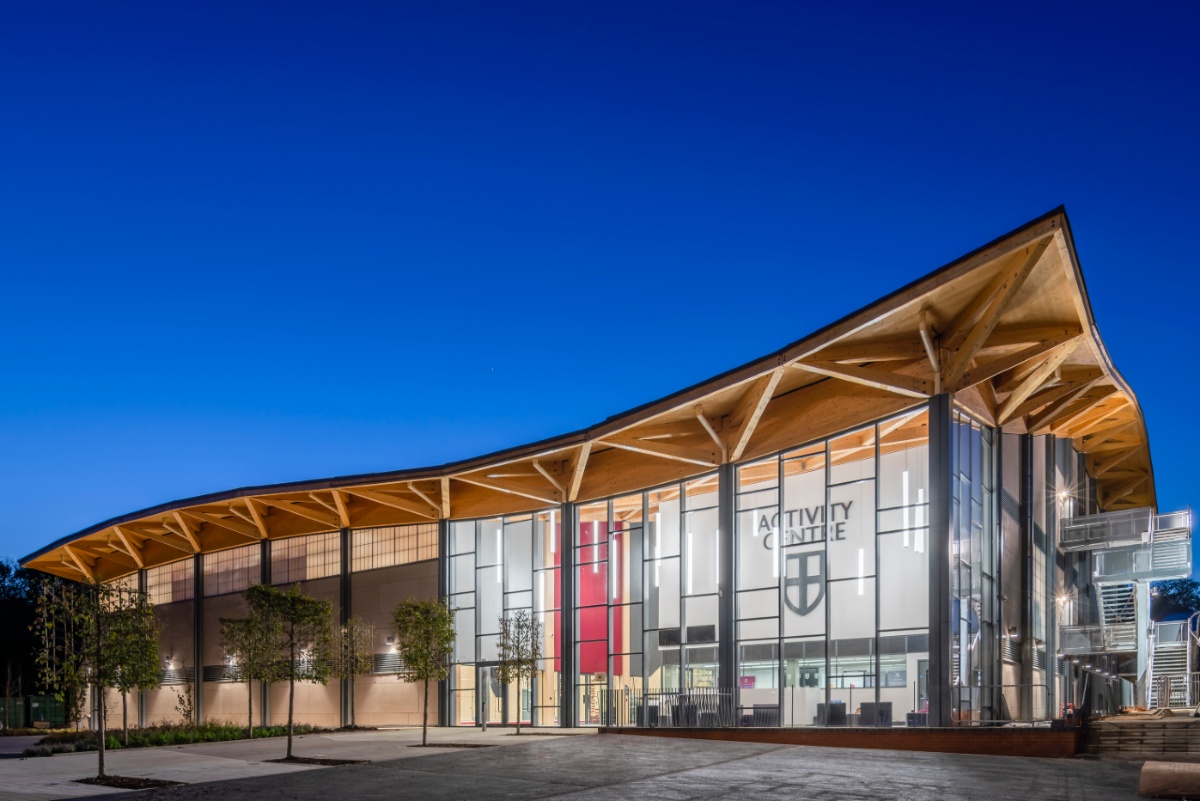The activity centre at St George’s College, Weybridge, was built to celebrate the 150th anniversary of the 1,000-pupil co-ed school. It places the needs of its students and the local community at its heart, with strong sustainable credentials and a number of modern features. Extensive use of VR in the design provided vital stakeholder engagement. A JCT Design and Build Contract was the contract solution.
Design by Scott Brownrigg, with Blenheim House Construction as the main contractor, the new activity centre at St George’s college, Weybridge (completed in October), is a sustainable and striking building providing a range of sports and other facilities for the pupils and local community. The 3-storey, 4,000m², building replaced a pre-existing 1980s prefabricated structure. With the site located on green-belt land it was important that the design and material choice was considerate towards, and reflective of, the local landscape.
The centre’s standout feature is its Glulam roof and CLT deck which spans the entirety of the activity spaces. It gives the building a gentle, wave-like form and a fluidity that helps it blend in with the surroundings. Inside, the CLT deck is expressed, which provides both a sense of drama and continuity across the different activity spaces. The free-form structure of the roof and the visual impact of the expressed CLT creates an inspirational space and a strong sense of identity, connecting the various functions, including main hall, central stair, dance studio, and viewing café. The use of timber references the surrounding natural landscape, but it also serves a functional purpose, sequestering carbon to help maintain a sustainable environment.
One of the main challenges to the construction was the 8 metre change in level across the site. The project team took the opportunity to incorporate an interesting design feature that provides a greater level of connectivity and access. A central movement spine was created to accommodate the various functions of the building across multiple levels. Taking inspiration from Wells Cathedral, the central staircase forms the focal point and creates a cathedral-like atmosphere within the main activity centre. Via the central spine, access is granted from the lower school campus, moves up through the sports studios, and finishes at the athletics track – joining the school together.
The centre’s facilities have all been designed and built to Sports England standards. The crowning glory is the multi-functional sports hall, which features a state-of-the-art sprung glass floor – the largest of its kind in the UK. It features an interactive, programmable LED line-marking system enabling various court and sports configurations to be activated at the push of a button. The ability to configure the space for the sport played rather than work with illegible over-lapping court lines dramatically improves performance within the space.
In addition to the sports hall, which also features a climbing wall at one end, the centre’s other facilities include a dance studio, a strength conditioning suite, changing rooms, and a number of multi-use areas for group activities, meetings, and exhibitions.
Sustainability has been a key driver on the project. Both in the construction and in considering the whole-life cycle of the building in use, materials and methods have been chosen that are both low impact and assist in maintaining a low-carbon environment. A fabric-first design approach was adopted to ensure that the form and orientation of the building were fully optimized before any renewable technology was used. The timber construction of the roof reduces embodied carbon, but also contains 200m² of solar photovoltaic panels to provide a renewable energy source.
A comfortable, low-energy environment is maintained by the use of various techniques. The combination of natural ventilation terminals and air source heat pumps to power under-floor heating provides efficient regulation for the main hall and atrium. The carefully chosen materials, such as opaque insulated light walls allow natural light to be diffused without problems of glare or over-heating. The roof also plays an additional role in low-energy maintenance with its efficient form providing large shaded overhangs.
Virtual Reality was an important tool in both the design and as a way to foster engagement throughout the project. The use of VR enabled a close collaboration between the client and the design team, refining key details and creating the ability for stakeholders to engage with the design and visualize the implications of certain design choices or layouts. Creating a virtual environment where stakeholders could explore the building sped up the decision-making process because members of the client team who were non-specialists could quickly and intuitively interact with the design to engage with issues that might be missed on plans or drawings. The use of VR was also important in engaging wider staff groups, and enabled the college to showcase the project, which was vital in gaining wider community support and funding.
With its flexibility, management of design, and adaptability to digital working, the JCT Design and Build Contract (DB) was the clear choice for this project. The VR design phase and collaboration between design team and client delivers a clear vision, enabling the project team to effectively manage the design requirements for the construction phase, which is well encapsulated by the use of DB. The pupils and community of St George’s College have an inspiring building which fosters health and wellbeing not only as its core purpose but also in its low impact, sustainable design and construction.
Project Information
Start: December 2017
Completion: October 2019
Cost: £15m
Contract: JCT Design and Build Contract
Gross internal floor area: 4,200m²
Client: St George’s College, Weybridge
Architect: Scott Brownrigg
Main Contractor: Blenheim House Construction
Quantity Surveyor and Project Manager: Madlins
Structural Engineer: DOA Consulting Structural Engineers
M&E Consultant: Desco
Landscape Consultant: Place Design & Planning
Acoustic Consultant: Hann Tucker
Approved Building Inspector: Butler & Young
CAD software: Renit, Landscape, Dynamo
Environmental Data
Annual CO2 emissions: 33.8kg/m²
On-site energy generation: 32kW peak PV system
Airtightness at 50pa: 3m³/h.m²
Overall area-weighted u-value: Average 0.35W/m²k
Design life: 25-year services, 50-year structure
Embodies/whole-life carbon: 33.8kgCO2eq/m²
Image: Hunden Clements Photography

